Business Environment Report: TESCO PLC Analysis and Impact
VerifiedAdded on 2020/06/04
|11
|3219
|490
Report
AI Summary
This report provides a comprehensive analysis of the business environment surrounding TESCO PLC, a major British multinational retailer. The report begins by defining the business environment and introducing TESCO. It then delves into the types and purposes of business organisations, differentiating between public, private, and voluntary sectors, and examines the size and scope of each. The report further explores the relationships between various organisational functions, such as marketing, finance, production, human resources, and R&D, and how these functions link with the overall objectives and structure of the organisation. Finally, the report assesses the positive and negative impacts of the macro environment on TESCO, utilizing PESTLE analysis to evaluate political, economic, social, technological, legal, and environmental factors. The conclusion summarizes the key findings and the interrelationship between these various elements.

BUSINESS
ENVIRONMENT
ENVIRONMENT
Paraphrase This Document
Need a fresh take? Get an instant paraphrase of this document with our AI Paraphraser
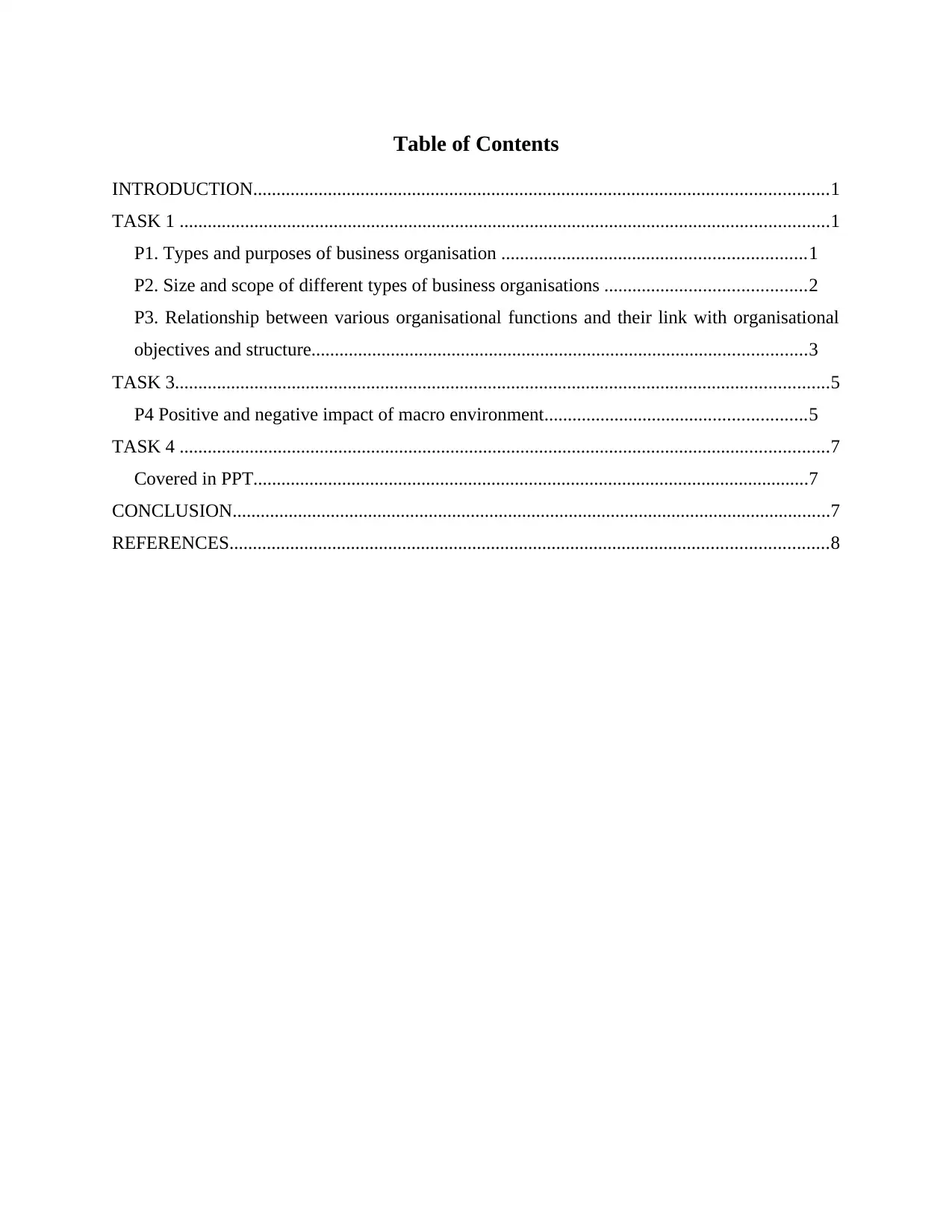
Table of Contents
INTRODUCTION...........................................................................................................................1
TASK 1 ...........................................................................................................................................1
P1. Types and purposes of business organisation .................................................................1
P2. Size and scope of different types of business organisations ...........................................2
P3. Relationship between various organisational functions and their link with organisational
objectives and structure..........................................................................................................3
TASK 3............................................................................................................................................5
P4 Positive and negative impact of macro environment........................................................5
TASK 4 ...........................................................................................................................................7
Covered in PPT.......................................................................................................................7
CONCLUSION................................................................................................................................7
REFERENCES................................................................................................................................8
INTRODUCTION...........................................................................................................................1
TASK 1 ...........................................................................................................................................1
P1. Types and purposes of business organisation .................................................................1
P2. Size and scope of different types of business organisations ...........................................2
P3. Relationship between various organisational functions and their link with organisational
objectives and structure..........................................................................................................3
TASK 3............................................................................................................................................5
P4 Positive and negative impact of macro environment........................................................5
TASK 4 ...........................................................................................................................................7
Covered in PPT.......................................................................................................................7
CONCLUSION................................................................................................................................7
REFERENCES................................................................................................................................8
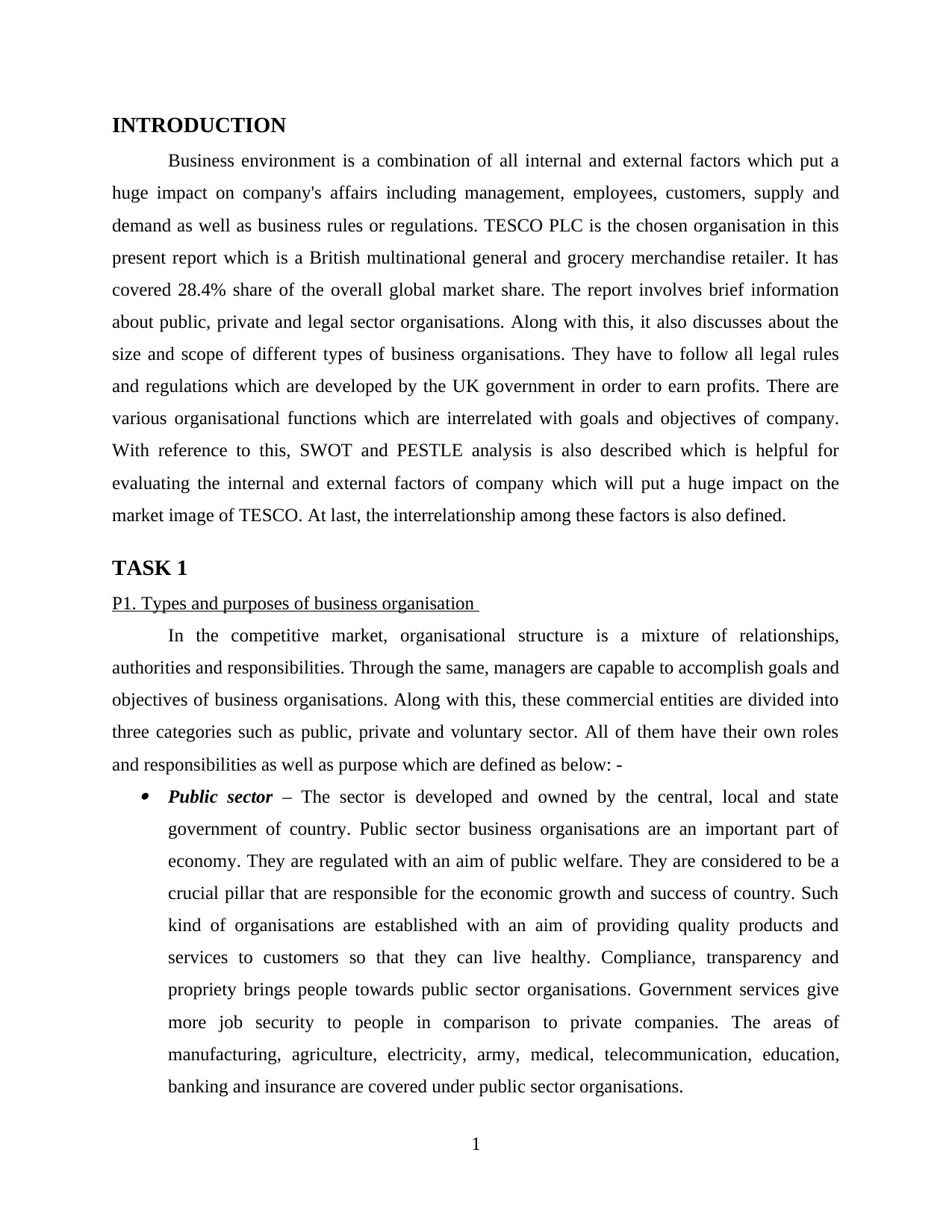
INTRODUCTION
Business environment is a combination of all internal and external factors which put a
huge impact on company's affairs including management, employees, customers, supply and
demand as well as business rules or regulations. TESCO PLC is the chosen organisation in this
present report which is a British multinational general and grocery merchandise retailer. It has
covered 28.4% share of the overall global market share. The report involves brief information
about public, private and legal sector organisations. Along with this, it also discusses about the
size and scope of different types of business organisations. They have to follow all legal rules
and regulations which are developed by the UK government in order to earn profits. There are
various organisational functions which are interrelated with goals and objectives of company.
With reference to this, SWOT and PESTLE analysis is also described which is helpful for
evaluating the internal and external factors of company which will put a huge impact on the
market image of TESCO. At last, the interrelationship among these factors is also defined.
TASK 1
P1. Types and purposes of business organisation
In the competitive market, organisational structure is a mixture of relationships,
authorities and responsibilities. Through the same, managers are capable to accomplish goals and
objectives of business organisations. Along with this, these commercial entities are divided into
three categories such as public, private and voluntary sector. All of them have their own roles
and responsibilities as well as purpose which are defined as below: - Public sector – The sector is developed and owned by the central, local and state
government of country. Public sector business organisations are an important part of
economy. They are regulated with an aim of public welfare. They are considered to be a
crucial pillar that are responsible for the economic growth and success of country. Such
kind of organisations are established with an aim of providing quality products and
services to customers so that they can live healthy. Compliance, transparency and
propriety brings people towards public sector organisations. Government services give
more job security to people in comparison to private companies. The areas of
manufacturing, agriculture, electricity, army, medical, telecommunication, education,
banking and insurance are covered under public sector organisations.
1
Business environment is a combination of all internal and external factors which put a
huge impact on company's affairs including management, employees, customers, supply and
demand as well as business rules or regulations. TESCO PLC is the chosen organisation in this
present report which is a British multinational general and grocery merchandise retailer. It has
covered 28.4% share of the overall global market share. The report involves brief information
about public, private and legal sector organisations. Along with this, it also discusses about the
size and scope of different types of business organisations. They have to follow all legal rules
and regulations which are developed by the UK government in order to earn profits. There are
various organisational functions which are interrelated with goals and objectives of company.
With reference to this, SWOT and PESTLE analysis is also described which is helpful for
evaluating the internal and external factors of company which will put a huge impact on the
market image of TESCO. At last, the interrelationship among these factors is also defined.
TASK 1
P1. Types and purposes of business organisation
In the competitive market, organisational structure is a mixture of relationships,
authorities and responsibilities. Through the same, managers are capable to accomplish goals and
objectives of business organisations. Along with this, these commercial entities are divided into
three categories such as public, private and voluntary sector. All of them have their own roles
and responsibilities as well as purpose which are defined as below: - Public sector – The sector is developed and owned by the central, local and state
government of country. Public sector business organisations are an important part of
economy. They are regulated with an aim of public welfare. They are considered to be a
crucial pillar that are responsible for the economic growth and success of country. Such
kind of organisations are established with an aim of providing quality products and
services to customers so that they can live healthy. Compliance, transparency and
propriety brings people towards public sector organisations. Government services give
more job security to people in comparison to private companies. The areas of
manufacturing, agriculture, electricity, army, medical, telecommunication, education,
banking and insurance are covered under public sector organisations.
1
⊘ This is a preview!⊘
Do you want full access?
Subscribe today to unlock all pages.

Trusted by 1+ million students worldwide
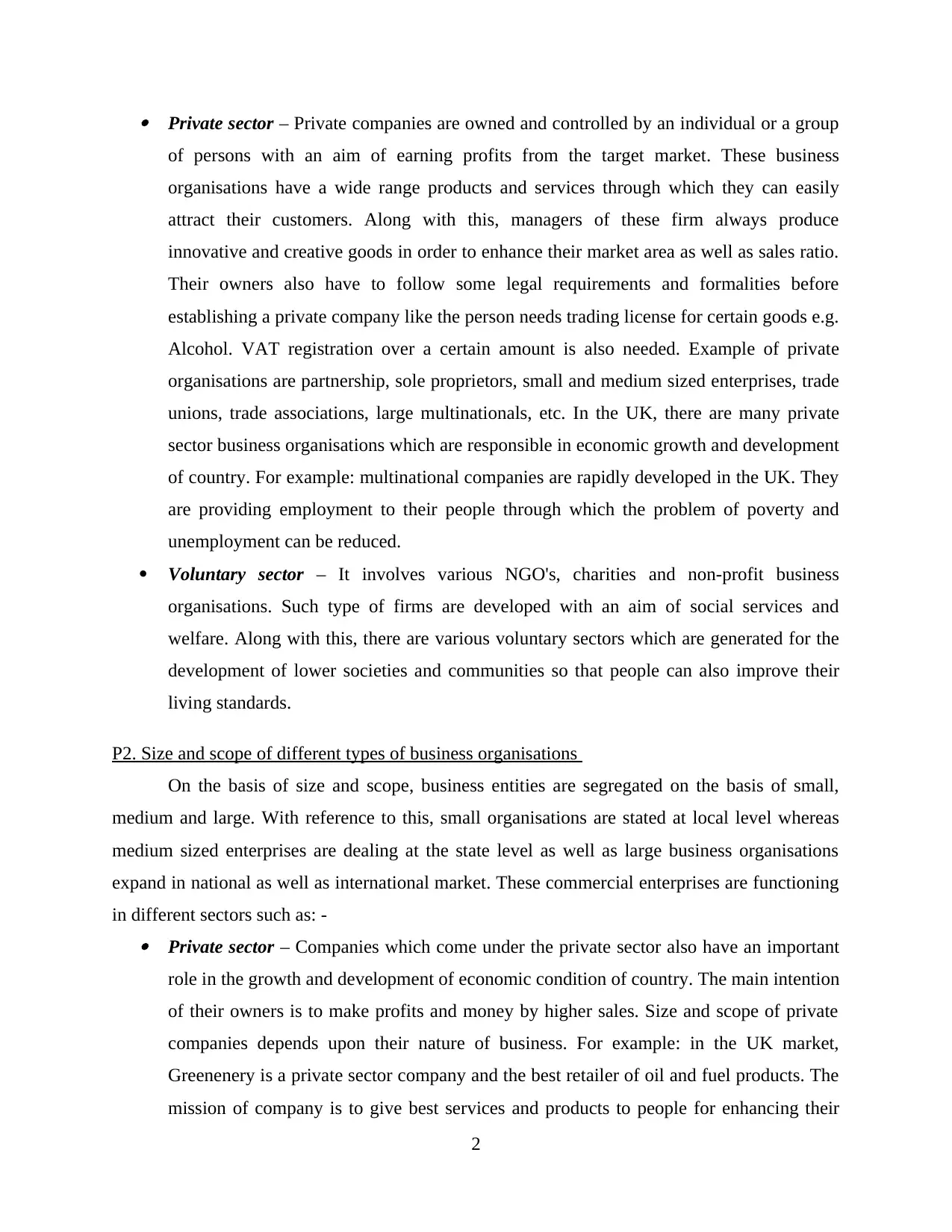
Private sector – Private companies are owned and controlled by an individual or a group
of persons with an aim of earning profits from the target market. These business
organisations have a wide range products and services through which they can easily
attract their customers. Along with this, managers of these firm always produce
innovative and creative goods in order to enhance their market area as well as sales ratio.
Their owners also have to follow some legal requirements and formalities before
establishing a private company like the person needs trading license for certain goods e.g.
Alcohol. VAT registration over a certain amount is also needed. Example of private
organisations are partnership, sole proprietors, small and medium sized enterprises, trade
unions, trade associations, large multinationals, etc. In the UK, there are many private
sector business organisations which are responsible in economic growth and development
of country. For example: multinational companies are rapidly developed in the UK. They
are providing employment to their people through which the problem of poverty and
unemployment can be reduced.
Voluntary sector – It involves various NGO's, charities and non-profit business
organisations. Such type of firms are developed with an aim of social services and
welfare. Along with this, there are various voluntary sectors which are generated for the
development of lower societies and communities so that people can also improve their
living standards.
P2. Size and scope of different types of business organisations
On the basis of size and scope, business entities are segregated on the basis of small,
medium and large. With reference to this, small organisations are stated at local level whereas
medium sized enterprises are dealing at the state level as well as large business organisations
expand in national as well as international market. These commercial enterprises are functioning
in different sectors such as: - Private sector – Companies which come under the private sector also have an important
role in the growth and development of economic condition of country. The main intention
of their owners is to make profits and money by higher sales. Size and scope of private
companies depends upon their nature of business. For example: in the UK market,
Greenenery is a private sector company and the best retailer of oil and fuel products. The
mission of company is to give best services and products to people for enhancing their
2
of persons with an aim of earning profits from the target market. These business
organisations have a wide range products and services through which they can easily
attract their customers. Along with this, managers of these firm always produce
innovative and creative goods in order to enhance their market area as well as sales ratio.
Their owners also have to follow some legal requirements and formalities before
establishing a private company like the person needs trading license for certain goods e.g.
Alcohol. VAT registration over a certain amount is also needed. Example of private
organisations are partnership, sole proprietors, small and medium sized enterprises, trade
unions, trade associations, large multinationals, etc. In the UK, there are many private
sector business organisations which are responsible in economic growth and development
of country. For example: multinational companies are rapidly developed in the UK. They
are providing employment to their people through which the problem of poverty and
unemployment can be reduced.
Voluntary sector – It involves various NGO's, charities and non-profit business
organisations. Such type of firms are developed with an aim of social services and
welfare. Along with this, there are various voluntary sectors which are generated for the
development of lower societies and communities so that people can also improve their
living standards.
P2. Size and scope of different types of business organisations
On the basis of size and scope, business entities are segregated on the basis of small,
medium and large. With reference to this, small organisations are stated at local level whereas
medium sized enterprises are dealing at the state level as well as large business organisations
expand in national as well as international market. These commercial enterprises are functioning
in different sectors such as: - Private sector – Companies which come under the private sector also have an important
role in the growth and development of economic condition of country. The main intention
of their owners is to make profits and money by higher sales. Size and scope of private
companies depends upon their nature of business. For example: in the UK market,
Greenenery is a private sector company and the best retailer of oil and fuel products. The
mission of company is to give best services and products to people for enhancing their
2
Paraphrase This Document
Need a fresh take? Get an instant paraphrase of this document with our AI Paraphraser
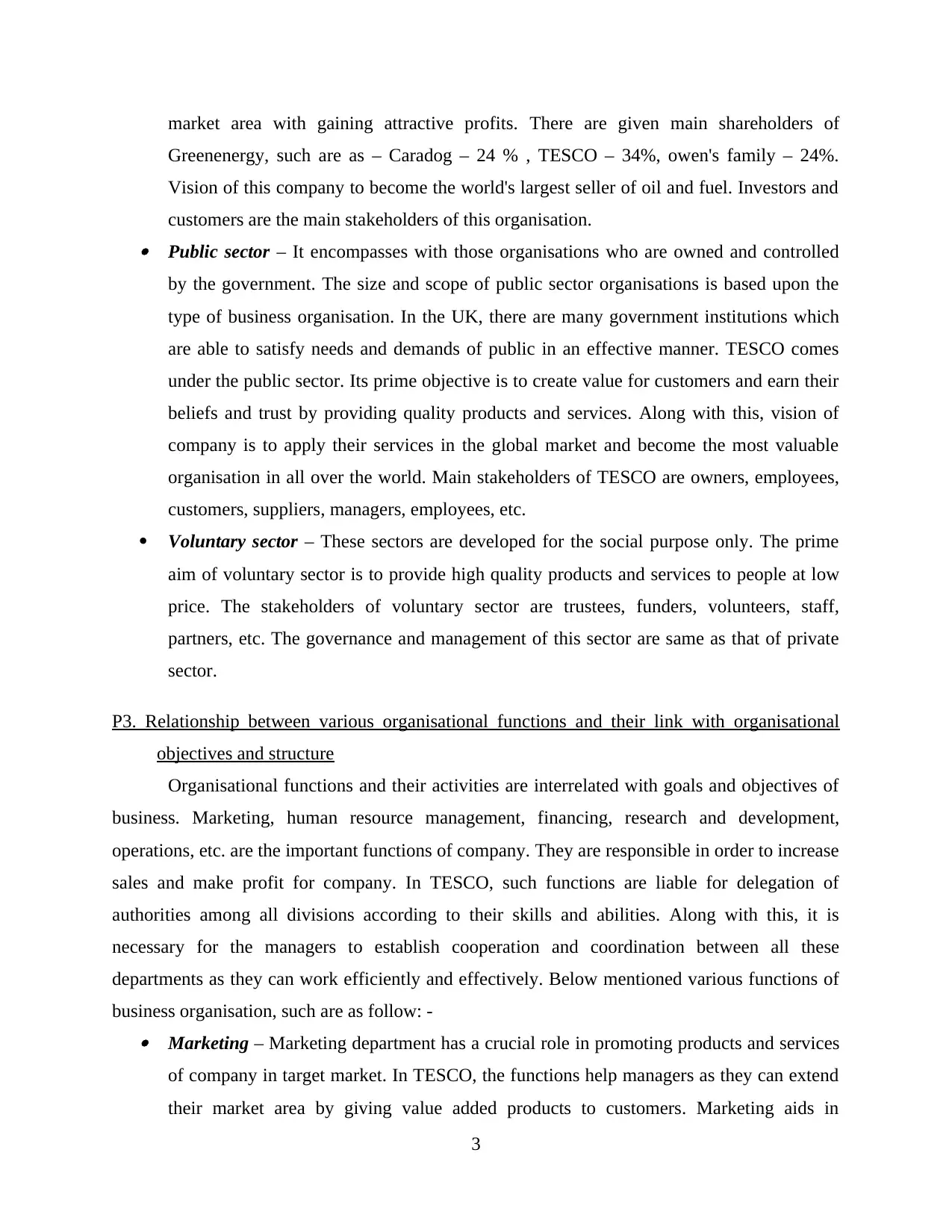
market area with gaining attractive profits. There are given main shareholders of
Greenenergy, such are as – Caradog – 24 % , TESCO – 34%, owen's family – 24%.
Vision of this company to become the world's largest seller of oil and fuel. Investors and
customers are the main stakeholders of this organisation. Public sector – It encompasses with those organisations who are owned and controlled
by the government. The size and scope of public sector organisations is based upon the
type of business organisation. In the UK, there are many government institutions which
are able to satisfy needs and demands of public in an effective manner. TESCO comes
under the public sector. Its prime objective is to create value for customers and earn their
beliefs and trust by providing quality products and services. Along with this, vision of
company is to apply their services in the global market and become the most valuable
organisation in all over the world. Main stakeholders of TESCO are owners, employees,
customers, suppliers, managers, employees, etc.
Voluntary sector – These sectors are developed for the social purpose only. The prime
aim of voluntary sector is to provide high quality products and services to people at low
price. The stakeholders of voluntary sector are trustees, funders, volunteers, staff,
partners, etc. The governance and management of this sector are same as that of private
sector.
P3. Relationship between various organisational functions and their link with organisational
objectives and structure
Organisational functions and their activities are interrelated with goals and objectives of
business. Marketing, human resource management, financing, research and development,
operations, etc. are the important functions of company. They are responsible in order to increase
sales and make profit for company. In TESCO, such functions are liable for delegation of
authorities among all divisions according to their skills and abilities. Along with this, it is
necessary for the managers to establish cooperation and coordination between all these
departments as they can work efficiently and effectively. Below mentioned various functions of
business organisation, such are as follow: - Marketing – Marketing department has a crucial role in promoting products and services
of company in target market. In TESCO, the functions help managers as they can extend
their market area by giving value added products to customers. Marketing aids in
3
Greenenergy, such are as – Caradog – 24 % , TESCO – 34%, owen's family – 24%.
Vision of this company to become the world's largest seller of oil and fuel. Investors and
customers are the main stakeholders of this organisation. Public sector – It encompasses with those organisations who are owned and controlled
by the government. The size and scope of public sector organisations is based upon the
type of business organisation. In the UK, there are many government institutions which
are able to satisfy needs and demands of public in an effective manner. TESCO comes
under the public sector. Its prime objective is to create value for customers and earn their
beliefs and trust by providing quality products and services. Along with this, vision of
company is to apply their services in the global market and become the most valuable
organisation in all over the world. Main stakeholders of TESCO are owners, employees,
customers, suppliers, managers, employees, etc.
Voluntary sector – These sectors are developed for the social purpose only. The prime
aim of voluntary sector is to provide high quality products and services to people at low
price. The stakeholders of voluntary sector are trustees, funders, volunteers, staff,
partners, etc. The governance and management of this sector are same as that of private
sector.
P3. Relationship between various organisational functions and their link with organisational
objectives and structure
Organisational functions and their activities are interrelated with goals and objectives of
business. Marketing, human resource management, financing, research and development,
operations, etc. are the important functions of company. They are responsible in order to increase
sales and make profit for company. In TESCO, such functions are liable for delegation of
authorities among all divisions according to their skills and abilities. Along with this, it is
necessary for the managers to establish cooperation and coordination between all these
departments as they can work efficiently and effectively. Below mentioned various functions of
business organisation, such are as follow: - Marketing – Marketing department has a crucial role in promoting products and services
of company in target market. In TESCO, the functions help managers as they can extend
their market area by giving value added products to customers. Marketing aids in
3

attaining and retaining more customers. There are various methods of marketing like
sales, personal selling, advertisement as well as online selling through which buyers can
easily attract towards company’s products. Finance and accounting – The finance department of TESCO is responsible to keep
manual records of cash received and paid out. It helps managers to make budgets and
various financial statements with the purpose of tax reduction and comply with legal
requirements. Manager of accounting department provide information to other managers
as they can make future business strategies as per the financial condition of company. If
the economical position of TESCO is strong, as it can provide quality products to
customers and it is can easily achieve goals and objectives from competitive market. At
last, this unit may also be helpful in administrating employee’s salaries and expenses. Production and operations – The prime role of production department is to produce
innovative goods and services for buyers as per their needs and demands. The production
and operation department is consists with new product development or improvising the
existing goods and services of company. . With the help of marketing research, owners
can easily identify what they should produce as well as the items that will help in
increasing sales and profits of company. If organisation has larger sales and higher
profits; then TESCO can accomplish its goals and objectives in an effective manner. Human resource management – It is the responsibility of HR manager to provide
training and development sessions to employees of Tesco as they become more
productive by the same. Well skilled and technical people are capable to give ideas
towards new product development. Such people are helpful for companies as they can
achieve goals and objectives of company.
Research & development – The unit of research and development helps to know needs
and wants of customers. Apart from this, by conducting a market research the research
manager finds the strength and power of competitors through which business
organisation can improve its existing business strategies and policies. Managers can also
take feedbacks and reviews of customers towards a particular product of company. This
will aids a company to accomplish its goals and objectives from competitive marketplace.
4
sales, personal selling, advertisement as well as online selling through which buyers can
easily attract towards company’s products. Finance and accounting – The finance department of TESCO is responsible to keep
manual records of cash received and paid out. It helps managers to make budgets and
various financial statements with the purpose of tax reduction and comply with legal
requirements. Manager of accounting department provide information to other managers
as they can make future business strategies as per the financial condition of company. If
the economical position of TESCO is strong, as it can provide quality products to
customers and it is can easily achieve goals and objectives from competitive market. At
last, this unit may also be helpful in administrating employee’s salaries and expenses. Production and operations – The prime role of production department is to produce
innovative goods and services for buyers as per their needs and demands. The production
and operation department is consists with new product development or improvising the
existing goods and services of company. . With the help of marketing research, owners
can easily identify what they should produce as well as the items that will help in
increasing sales and profits of company. If organisation has larger sales and higher
profits; then TESCO can accomplish its goals and objectives in an effective manner. Human resource management – It is the responsibility of HR manager to provide
training and development sessions to employees of Tesco as they become more
productive by the same. Well skilled and technical people are capable to give ideas
towards new product development. Such people are helpful for companies as they can
achieve goals and objectives of company.
Research & development – The unit of research and development helps to know needs
and wants of customers. Apart from this, by conducting a market research the research
manager finds the strength and power of competitors through which business
organisation can improve its existing business strategies and policies. Managers can also
take feedbacks and reviews of customers towards a particular product of company. This
will aids a company to accomplish its goals and objectives from competitive marketplace.
4
⊘ This is a preview!⊘
Do you want full access?
Subscribe today to unlock all pages.

Trusted by 1+ million students worldwide

TASK 3
P4 Positive and negative impact of macro environment
Macro business environment is consists with major external and uncontrollable factors. It
influence an organisation's decision making process and it impact on performance as well as
strategies of company. In TESCO, macro environment relates with the situation which affects
whole economic condition of the company rather than a particular department. With the help of
PESTLE analysis, managers can easily evaluate those external factors which brunt market
position of company. Below mentioned the components which are involved in PESTLE analysis,
such are as follow: - Political factors – TESCO operates all over the world, global political factors highly
dominate its performance and productivity as well. It involves- tax rates, trade policies,
revenues etc. due to the ongoing economic crisis in the world, many countries motivate
such retailers as to create jobs and employment for the population. Cited company extend
in almost countries of the world as it is able to generate job opportunities for their people
(Commander and Svejnar, 2011). Through which it is able to diversify workforce and
increases the demand of products and services. Economical factors – these factors having the main point of concern for TESCO; it
involves, i.e. leverage cost, demand, supply, prices, profits etc. If the economical
condition of UK is positive then it is good for TESCO cause it results in the growth and
development of supermarket industries. Higher rate of economic growth helps country as
it can easily recover from the financial crises. Economic factors put a positive impact on
TESCO success, internationalization and diversification, these two key strategies
adopted by the company over the years through which it can earn more profits from
global market. But the negative impact is due to the decline in household and disposable
income, people will decreased spending money on luxurious products and moving
towards value brand things. Therefore, TESCO needs to be aware towards any change in
economic rules and policies. Social factors – the goods and services which are demanded by customers, are influenced
their values, morals and beliefs. In modern world, needs and demands of customers are
rapidly change; now they are more tend towards health. For this purpose, their
requirements towards foods is also changed. Therefore, TESCO needs to pursued these
5
P4 Positive and negative impact of macro environment
Macro business environment is consists with major external and uncontrollable factors. It
influence an organisation's decision making process and it impact on performance as well as
strategies of company. In TESCO, macro environment relates with the situation which affects
whole economic condition of the company rather than a particular department. With the help of
PESTLE analysis, managers can easily evaluate those external factors which brunt market
position of company. Below mentioned the components which are involved in PESTLE analysis,
such are as follow: - Political factors – TESCO operates all over the world, global political factors highly
dominate its performance and productivity as well. It involves- tax rates, trade policies,
revenues etc. due to the ongoing economic crisis in the world, many countries motivate
such retailers as to create jobs and employment for the population. Cited company extend
in almost countries of the world as it is able to generate job opportunities for their people
(Commander and Svejnar, 2011). Through which it is able to diversify workforce and
increases the demand of products and services. Economical factors – these factors having the main point of concern for TESCO; it
involves, i.e. leverage cost, demand, supply, prices, profits etc. If the economical
condition of UK is positive then it is good for TESCO cause it results in the growth and
development of supermarket industries. Higher rate of economic growth helps country as
it can easily recover from the financial crises. Economic factors put a positive impact on
TESCO success, internationalization and diversification, these two key strategies
adopted by the company over the years through which it can earn more profits from
global market. But the negative impact is due to the decline in household and disposable
income, people will decreased spending money on luxurious products and moving
towards value brand things. Therefore, TESCO needs to be aware towards any change in
economic rules and policies. Social factors – the goods and services which are demanded by customers, are influenced
their values, morals and beliefs. In modern world, needs and demands of customers are
rapidly change; now they are more tend towards health. For this purpose, their
requirements towards foods is also changed. Therefore, TESCO needs to pursued these
5
Paraphrase This Document
Need a fresh take? Get an instant paraphrase of this document with our AI Paraphraser
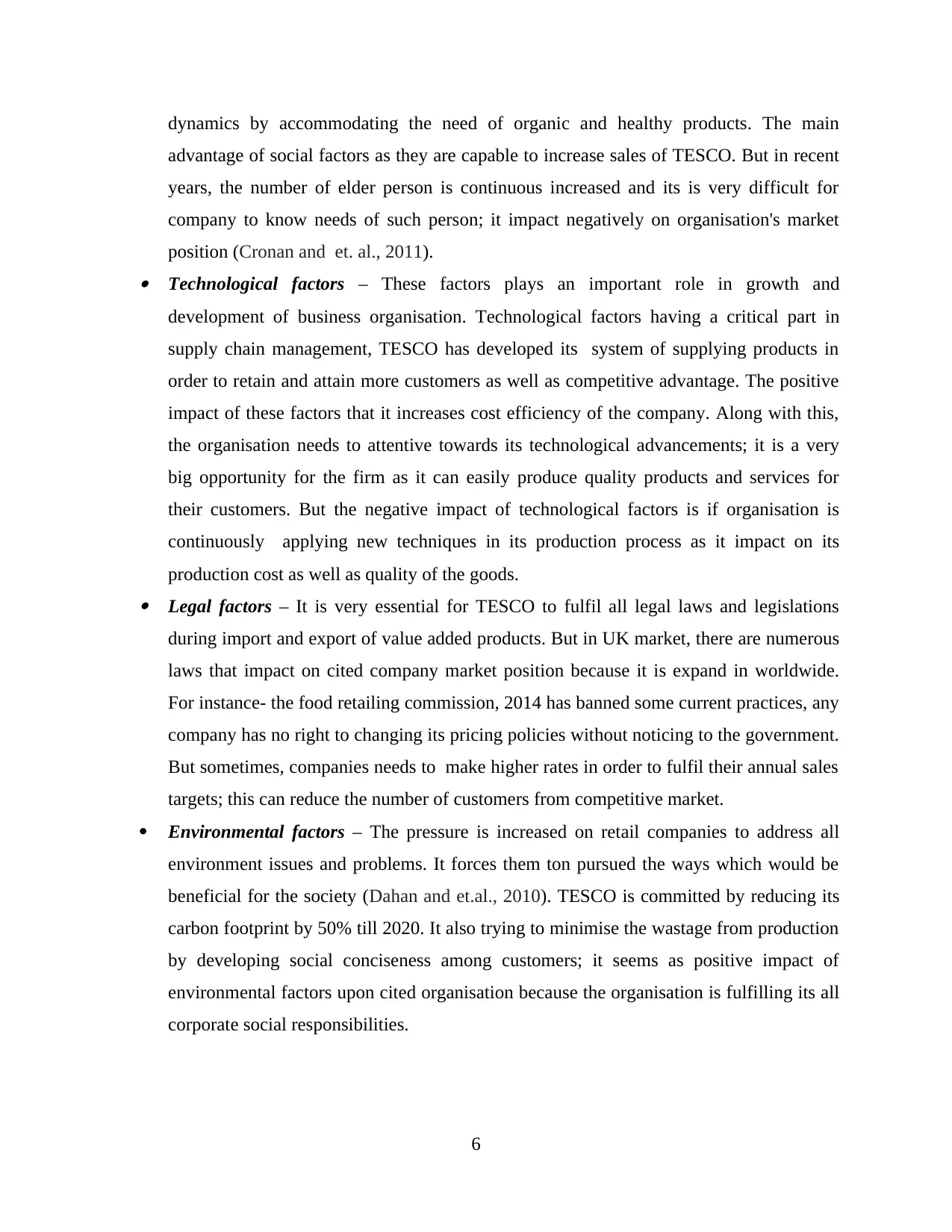
dynamics by accommodating the need of organic and healthy products. The main
advantage of social factors as they are capable to increase sales of TESCO. But in recent
years, the number of elder person is continuous increased and its is very difficult for
company to know needs of such person; it impact negatively on organisation's market
position (Cronan and et. al., 2011). Technological factors – These factors plays an important role in growth and
development of business organisation. Technological factors having a critical part in
supply chain management, TESCO has developed its system of supplying products in
order to retain and attain more customers as well as competitive advantage. The positive
impact of these factors that it increases cost efficiency of the company. Along with this,
the organisation needs to attentive towards its technological advancements; it is a very
big opportunity for the firm as it can easily produce quality products and services for
their customers. But the negative impact of technological factors is if organisation is
continuously applying new techniques in its production process as it impact on its
production cost as well as quality of the goods. Legal factors – It is very essential for TESCO to fulfil all legal laws and legislations
during import and export of value added products. But in UK market, there are numerous
laws that impact on cited company market position because it is expand in worldwide.
For instance- the food retailing commission, 2014 has banned some current practices, any
company has no right to changing its pricing policies without noticing to the government.
But sometimes, companies needs to make higher rates in order to fulfil their annual sales
targets; this can reduce the number of customers from competitive market.
Environmental factors – The pressure is increased on retail companies to address all
environment issues and problems. It forces them ton pursued the ways which would be
beneficial for the society (Dahan and et.al., 2010). TESCO is committed by reducing its
carbon footprint by 50% till 2020. It also trying to minimise the wastage from production
by developing social conciseness among customers; it seems as positive impact of
environmental factors upon cited organisation because the organisation is fulfilling its all
corporate social responsibilities.
6
advantage of social factors as they are capable to increase sales of TESCO. But in recent
years, the number of elder person is continuous increased and its is very difficult for
company to know needs of such person; it impact negatively on organisation's market
position (Cronan and et. al., 2011). Technological factors – These factors plays an important role in growth and
development of business organisation. Technological factors having a critical part in
supply chain management, TESCO has developed its system of supplying products in
order to retain and attain more customers as well as competitive advantage. The positive
impact of these factors that it increases cost efficiency of the company. Along with this,
the organisation needs to attentive towards its technological advancements; it is a very
big opportunity for the firm as it can easily produce quality products and services for
their customers. But the negative impact of technological factors is if organisation is
continuously applying new techniques in its production process as it impact on its
production cost as well as quality of the goods. Legal factors – It is very essential for TESCO to fulfil all legal laws and legislations
during import and export of value added products. But in UK market, there are numerous
laws that impact on cited company market position because it is expand in worldwide.
For instance- the food retailing commission, 2014 has banned some current practices, any
company has no right to changing its pricing policies without noticing to the government.
But sometimes, companies needs to make higher rates in order to fulfil their annual sales
targets; this can reduce the number of customers from competitive market.
Environmental factors – The pressure is increased on retail companies to address all
environment issues and problems. It forces them ton pursued the ways which would be
beneficial for the society (Dahan and et.al., 2010). TESCO is committed by reducing its
carbon footprint by 50% till 2020. It also trying to minimise the wastage from production
by developing social conciseness among customers; it seems as positive impact of
environmental factors upon cited organisation because the organisation is fulfilling its all
corporate social responsibilities.
6
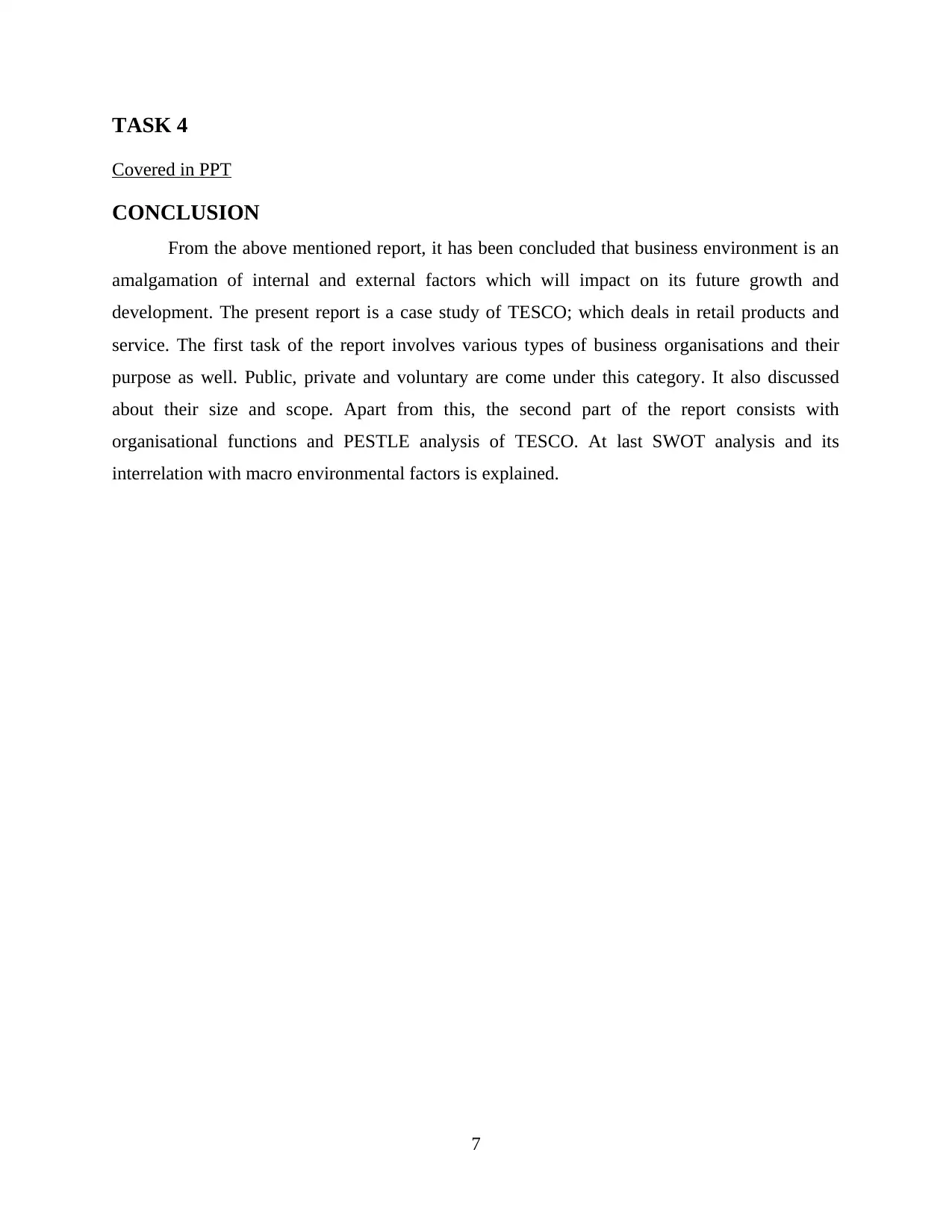
TASK 4
Covered in PPT
CONCLUSION
From the above mentioned report, it has been concluded that business environment is an
amalgamation of internal and external factors which will impact on its future growth and
development. The present report is a case study of TESCO; which deals in retail products and
service. The first task of the report involves various types of business organisations and their
purpose as well. Public, private and voluntary are come under this category. It also discussed
about their size and scope. Apart from this, the second part of the report consists with
organisational functions and PESTLE analysis of TESCO. At last SWOT analysis and its
interrelation with macro environmental factors is explained.
7
Covered in PPT
CONCLUSION
From the above mentioned report, it has been concluded that business environment is an
amalgamation of internal and external factors which will impact on its future growth and
development. The present report is a case study of TESCO; which deals in retail products and
service. The first task of the report involves various types of business organisations and their
purpose as well. Public, private and voluntary are come under this category. It also discussed
about their size and scope. Apart from this, the second part of the report consists with
organisational functions and PESTLE analysis of TESCO. At last SWOT analysis and its
interrelation with macro environmental factors is explained.
7
⊘ This is a preview!⊘
Do you want full access?
Subscribe today to unlock all pages.

Trusted by 1+ million students worldwide

REFERENCES
Books and Journal
Agarwal, R., Grassl, W. and Pahl, J., 2012. Meta-SWOT: introducing a new strategic planning
tool. Journal of Business Strategy. 33(2). pp.12-21.
Aterido, R., Hallward-Driemeier, M. and Pagés, C., 2011. Big constraints to small firms’
growth? Business environment and employment growth across firms. Economic
Development and Cultural Change. 59(3). pp.609-647.
Auzair, S., 2011. The effect of business strategy and external environment on management
control systems: a study of Malaysian hotels. International Journal of Business and
Social Science. 2(13).
Avramenko, A., 2012. Enhancing students' employability through business simulation.
Education+ Training. 54(5). pp.355-367.
Burns, C. and Winter, S., 2011. Introduction. Australian Farm Business Management
Journal. 8(2). p.iv.
Chow, A. T. and et. al., 2011. Broadband network with enterprise wireless communication
system for residential and business environment. U.S. Patent 7.944,948.
Commander, S. and Svejnar, J., 2011. Business environment, exports, ownership, and firm
performance. The Review of Economics and Statistics. 93(1). pp.309-337.
Cronan, T. P. and et. al., 2011. Decision making in an integrated business process context:
Learning using an ERP simulation game. Decision Sciences Journal of Innovative
Education. 9(2). pp.227-234.
Dahan, N. M. and et.al., 2010. Corporate-NGO collaboration: Co-creating new business models
for developing markets. Long range planning. 43(2). pp.326-342.
Fernando, A.C., 2011. Business environment. Pearson Education India.
Gebauer, H., Paiola, M. and Edvardsson, B., 2010. Service business development in small and
medium capital goods manufacturing companies. Managing Service Quality: An
International Journal. 20(2). pp.123-139.
Halbert, T. and Ingulli, E., 2011.Law and ethics in the business environment. Cengage Learning.'
Hamilton, L. and Webster, P., 2015.The international business environment. Oxford University
Press, USA.
López-Gamero, M.D., Molina-Azorín, J.F. and Claver-Cortés, E., 2011. Environmental
uncertainty and environmental management perception: A multiple case study. Journal
of Business Research. 64(4). pp.427-435.
Mahmood, R. and Hanafi, N., 2013. Entrepreneurial orientation and business performance of
women-owned small and medium enterprises in malaysia: competitive advantage as a
mediator. International Journal of Business and Social Science. 4(1).
Online
What Are the Functions of Organizational Structure?, 2017. [Online].
Available through: <http://yourbusiness.azcentral.com/functions-
organizational-structure-2141.html>. [Accessed on 14th July 2017].
8
Books and Journal
Agarwal, R., Grassl, W. and Pahl, J., 2012. Meta-SWOT: introducing a new strategic planning
tool. Journal of Business Strategy. 33(2). pp.12-21.
Aterido, R., Hallward-Driemeier, M. and Pagés, C., 2011. Big constraints to small firms’
growth? Business environment and employment growth across firms. Economic
Development and Cultural Change. 59(3). pp.609-647.
Auzair, S., 2011. The effect of business strategy and external environment on management
control systems: a study of Malaysian hotels. International Journal of Business and
Social Science. 2(13).
Avramenko, A., 2012. Enhancing students' employability through business simulation.
Education+ Training. 54(5). pp.355-367.
Burns, C. and Winter, S., 2011. Introduction. Australian Farm Business Management
Journal. 8(2). p.iv.
Chow, A. T. and et. al., 2011. Broadband network with enterprise wireless communication
system for residential and business environment. U.S. Patent 7.944,948.
Commander, S. and Svejnar, J., 2011. Business environment, exports, ownership, and firm
performance. The Review of Economics and Statistics. 93(1). pp.309-337.
Cronan, T. P. and et. al., 2011. Decision making in an integrated business process context:
Learning using an ERP simulation game. Decision Sciences Journal of Innovative
Education. 9(2). pp.227-234.
Dahan, N. M. and et.al., 2010. Corporate-NGO collaboration: Co-creating new business models
for developing markets. Long range planning. 43(2). pp.326-342.
Fernando, A.C., 2011. Business environment. Pearson Education India.
Gebauer, H., Paiola, M. and Edvardsson, B., 2010. Service business development in small and
medium capital goods manufacturing companies. Managing Service Quality: An
International Journal. 20(2). pp.123-139.
Halbert, T. and Ingulli, E., 2011.Law and ethics in the business environment. Cengage Learning.'
Hamilton, L. and Webster, P., 2015.The international business environment. Oxford University
Press, USA.
López-Gamero, M.D., Molina-Azorín, J.F. and Claver-Cortés, E., 2011. Environmental
uncertainty and environmental management perception: A multiple case study. Journal
of Business Research. 64(4). pp.427-435.
Mahmood, R. and Hanafi, N., 2013. Entrepreneurial orientation and business performance of
women-owned small and medium enterprises in malaysia: competitive advantage as a
mediator. International Journal of Business and Social Science. 4(1).
Online
What Are the Functions of Organizational Structure?, 2017. [Online].
Available through: <http://yourbusiness.azcentral.com/functions-
organizational-structure-2141.html>. [Accessed on 14th July 2017].
8
Paraphrase This Document
Need a fresh take? Get an instant paraphrase of this document with our AI Paraphraser

9
1 out of 11
Related Documents
Your All-in-One AI-Powered Toolkit for Academic Success.
+13062052269
info@desklib.com
Available 24*7 on WhatsApp / Email
![[object Object]](/_next/static/media/star-bottom.7253800d.svg)
Unlock your academic potential
Copyright © 2020–2025 A2Z Services. All Rights Reserved. Developed and managed by ZUCOL.





